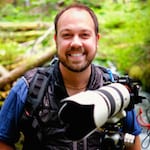Let’s migrate from the inland rolling hills of the Palouse to the rocky, rugged coastline of Oregon’s Ecola State Park. I have only visited this park once, located near the famous Cannon Beach. It’s a great place for anyone looking to improve their seascape and long exposure photography skills because the coast is littered with all sorts of rock, varying in size and shape.
When we arrived, we had about two hours before the sun was scheduled to set and the weather was what you’d expect for Oregon in early January—namely, overcast and cold. Perfect for what I wanted to do! Often times, when I have so many varying shapes in front of me, I have to pay extra attention to keeping my focus. It’s pretty easy for my mind to wander, looking for the next shot, when I really should be focusing on finding the best way to compose what’s in front of me at that moment. First on my agenda was to find a way to make order out of the large number of rocks in front of me. There was this larger formation in the distance that had some sort of lichen growing on the top. I knew that I wanted to include it here. I aligned myself in such a way that the effect of my long exposure created a visible channel leading right to the big rock in the background. I love those subtle compositional cues when they work.
Next, I challenged myself to reduce the number of rocks in the scene, which required me to get my feet nice and wet. I found an isolated boulder flanked by a few others with the same huge rock formation positioned right behind it. I instantly knew that this would be a composition that I’d enjoy. Again, I opted to use a neutral density filter because I didn’t want the waves to distract the viewer from the rock, and to be honest, I love the effect neutral density filters have with ocean water.
Despite it probably being obvious to most, it took me almost 30 minutes to notice a little island with a lighthouse perched atop it way in the distance. I was so focused on the stuff in my immediate vicinity that I must have overlooked it. However, with it now in my sights, all I could concentrate on was incorporating it into my composition in a clever and interesting way.
My first inclination was to find a way to nestle the little island in between a cluster of rocks but all that did was add clutter. I also tried a vertical crop, hoping that it would create a stronger visual path to the island, but that also fell flat. After a while, I was beginning to think that there would be no ideal way to get the composition that I had in my mind.
The solution ended up presenting itself in the form of a compromise. In order for me to find a composition that clearly defined the island while still maintaining strong leading lines, I would have to discard the notion of keeping a bunch of rocks in the frame. Instead, I climbed atop one of the rocks and walked out towards the large haystack rock I mentioned earlier. Doing so put all the other little rocks outside of my periphery, resulting in me finding a composition I liked quite quickly. I was able to keep the island isolated while still including a good amount of the rocky terrain in the foreground and, again, the long exposure
Stylization was pretty straightforward here. I adjusted the natural tone and color of the scene with the temperature and split toning sliders… but only slightly. The rest of the processing was to correct for saturation and sharpening. Not much else was needed here, which I was thankful for.
Questions about this column?
Just leave them in the Comments section and I’ll make sure to address them!
 Brian Matiash is a Portland-based published photographer and author. He is a member of Sony’s Artisans of Imagery as well as the owner of Matiash, Inc. and the Matiash Shop.
Brian Matiash is a Portland-based published photographer and author. He is a member of Sony’s Artisans of Imagery as well as the owner of Matiash, Inc. and the Matiash Shop.
To find out more about Brian’s work, click here. To get his new eBook, Stories from the Lens, for free, sign up to his newsletter.
This Post Sponsored by:
Perfectly Clear is all about saving you time so you can focus on doing what you love best. Get a free trial of the award winning plug-in at http://bit.ly/perfectlyclear1
The HDR Learning Center. Check out new ways to use High Dynamic Range photography to make compelling images. Free tutorials and posts to get results. Produced in partnership with HDRsoft
Arizona Highways Photo Workshops. For more than 30 years, Arizona Highway Photo Workshops has been committed to helping photographers find inspiring destinations, quality education and spectacular images. Get more information (and enter our contest) at http://www.ahpw.org/FindIt/
Platypod Pro™– the world’s most compact camera support. Use it with your ballhead in place of a tripod. Click here for more info — http://bit.ly/platypodpro
Creative Cloud Photography plan. Take your best shot and make it even better with the Creative Cloud Photography plan. Get all the essential tools, including Adobe Photoshop Lightroom and Photoshop, to craft incredible images every day, everywhere — whether you’re a beginner or a pro. It’s all your photography. All in one place.
lynda.com Learn photography anytime, anywhere, and at your own pace—from bite-sized tutorials to comprehensive courses. Try lynda.com free for 10 days by visiting lynda.com/Photofocus
Filed under: Inspiration, Opinion, Photography, Software, Technique & Tutorials Tagged: Brian Matiash, how to, inspiration, Landscape, long exposure, method_bm, Oregon, photo methodology
![]()









